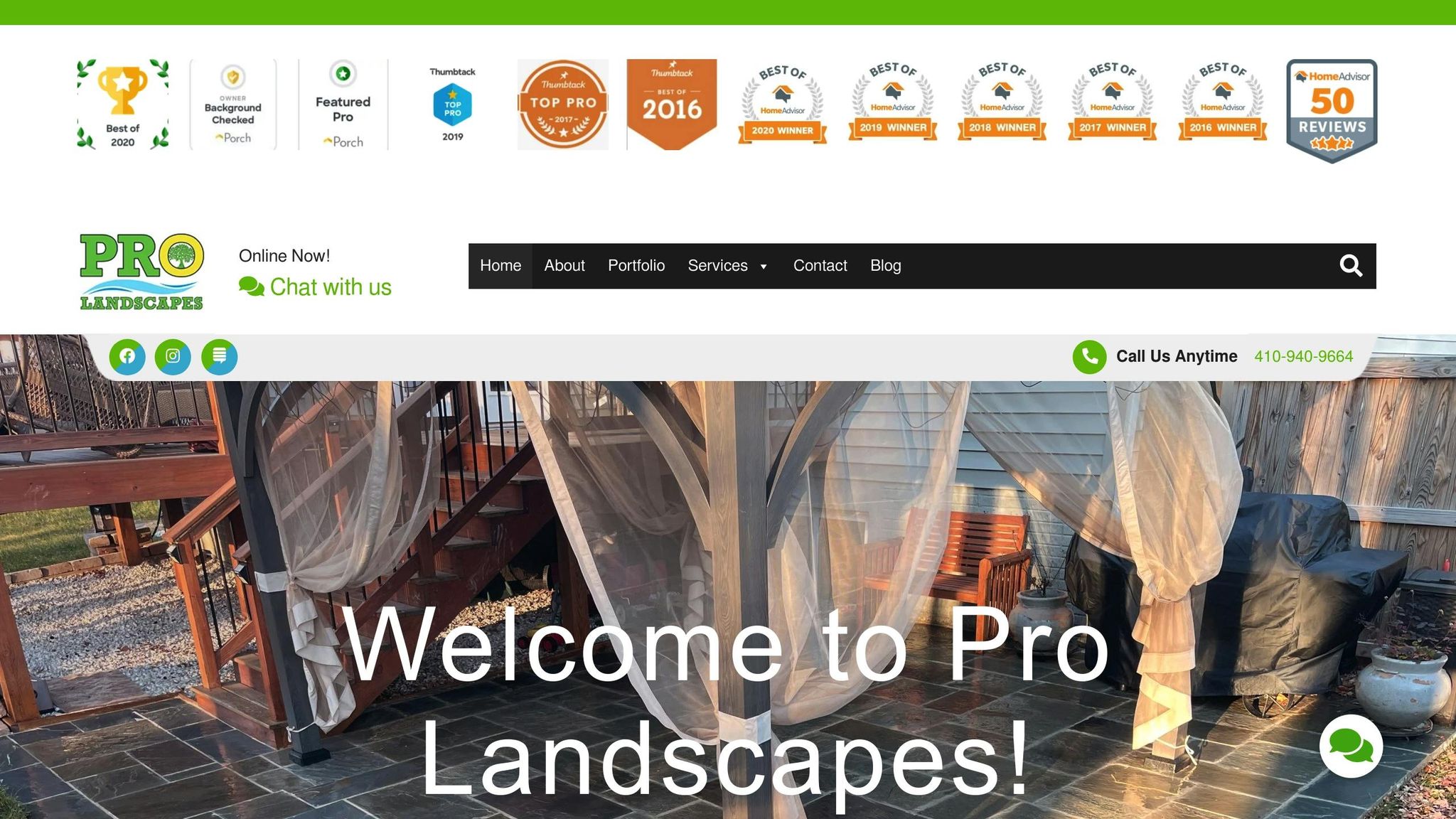- bhavya gada
- No Comments
Want a greener yard that helps the environment and saves you money? Start by adopting eco-friendly gardening practices. Here’s how you can make a difference:
- Plant Native Species: Support local ecosystems with Maryland-native plants like Eastern Redbud or Black-Eyed Susan, which require less water and maintenance.
- Compost at Home: Turn kitchen scraps and yard waste into nutrient-rich soil while reducing landfill waste.
- Save Water: Install drip irrigation systems to cut water usage by up to 60%.
- Skip Chemicals: Use natural pest control methods like companion planting and homemade sprays.
- Mulch Your Garden: Conserve soil moisture, regulate temperature, and reduce weeds with organic mulches.
- Build a Rain Garden: Manage stormwater runoff and prevent flooding with strategically placed rain gardens.
- Replace Grass with Ground Covers: Opt for low-maintenance alternatives like Pennsylvania Sedge to save water and reduce mowing.
- Plant for Pollinators: Attract bees and butterflies with native flowers like Butterfly Weed and Black-Eyed Susan.
- Use Sustainable Materials: Create garden paths and walls using permeable pavers or recycled materials.
- Work with Experts: Partner with local eco-conscious landscapers to design a sustainable yard.
Quick Benefits: Lower water bills, less maintenance, healthier soil, and a thriving habitat for local wildlife. Ready to start? Choose one practice today and watch your yard transform!
Eco-friendly garden design – saves you money, makes your …
1. Choose Maryland Native Plants
Opt for Maryland native plants to create a garden that’s eco-friendly, hardy, and requires minimal upkeep.
The University of Maryland Extension‘s 2024 report highlights several native species that thrive in local gardens. Here’s a quick guide to some top choices:
| Plant Type | Recommended Native Species | Benefits |
|---|---|---|
| Trees | Eastern Redbud, White Oak | Provide shade and support local wildlife |
| Shrubs | Black Chokeberry, Winterberry Holly | Add year-round interest and produce berries |
| Wildflowers | Black-Eyed Susan, Cardinal Flower | Attract pollinators and brighten your garden |
| Grasses | Little Bluestem, Switchgrass | Help control erosion and need little maintenance |
Research by Desiree Narango shows that backyards with at least 70% native plant biomass (or less than 30% non-native plants) are better at supporting Carolina chickadee populations. In contrast, gardens dominated by non-native species see reduced breeding success.
"Native plants are generally easier to grow and cheaper to maintain…they are generally easier to care for once they are established, needing little or no pruning, deadheading, watering, or fertilizing."
Switchgrass (Panicum virgatum) is a standout for erosion control. Its deep roots, stretching 5–6 feet, stabilize soil and handle both drought and floods. Cultivars like "Cloud Nine" and "Shenandoah" are particularly well-suited for Maryland landscapes.
When selecting native plants, think about your yard’s sunlight, soil type, moisture levels, and available space. For example, native oaks can support over 530 species of butterflies and moths, while invasive butterfly bush supports just one. This dramatic difference highlights how native plants play a key role in preserving biodiversity.
Pair these native options with other eco-friendly gardening practices to make your yard even more sustainable.
2. Make Your Own Compost
Transform your kitchen scraps and yard waste into nutrient-packed soil with a simple composting setup tailored for Maryland gardens. Did you know that 59% of municipal waste – like yard trimmings, food scraps, and paper – is compostable?
The key to successful composting lies in balancing two main components:
| Material Type | Examples | Purpose |
|---|---|---|
| Browns (Carbon-rich) | Dry leaves, straw, wood chips, shredded paper | Adds structure and slow-release energy |
| Greens (Nitrogen-rich) | Grass clippings, vegetable scraps, coffee grounds | Provides moisture and quick-release nutrients |
Aim for a carbon-to-nitrogen ratio between 25:1 and 40:1, with 30:1 being the sweet spot. A good rule of thumb: use about three parts browns to one part greens by volume.
Tips for a Healthy Compost Pile
- Pick the right spot: Choose a level, well-drained area with partial shade.
- Layer materials: Start with browns, then alternate with greens.
- Moisture and aeration: Keep the pile damp like a wrung-out sponge and turn it every 1–2 weeks to introduce oxygen and speed up decomposition.
Hot composting works best when the pile reaches 130°F–140°F. If the pile feels cool, it’s time to turn it for better airflow.
Items to Keep Out of Your Compost
Avoid adding the following:
- Meat and dairy products
- Oily foods (like cooking oil)
- Pet waste
- Diseased plants
- Synthetic fabrics
- Large amounts of wood ash
For faster results, chop materials into smaller pieces. Hot composting can produce finished compost in 6–8 weeks, while cool composting typically takes about a year.
When your compost is ready, it will have a crumbly texture and an earthy smell. Use it to enrich your garden soil or as a natural mulch to improve soil structure and provide nutrients for healthy plant growth. Up next: learn how to make the most of water with efficient irrigation techniques.
3. Set Up Water-Saving Irrigation
Save on water bills while keeping your garden thriving with drip irrigation. Unlike sprinklers, which use 12-30 gallons per minute, drip systems deliver a much more efficient 1-4 gallons per hour.
How Drip Irrigation Works
Drip systems use a network of tubes and emitters to deliver water directly to the root zone of plants. This focused method offers several advantages:
| Feature | Advantage |
|---|---|
| Root-zone delivery | Up to 90% water absorption compared to 65-75% with sprinklers |
| Slow release | Minimizes runoff and nutrient loss |
| Ground-level distribution | Keeps leaves dry, reducing mildew risk |
| Precise control | Can lower water use by up to 60% |
Setting Up Your System
To get started, group plants with similar water needs together. For instance, vegetables and herbs can share one watering zone, while drought-tolerant plants can be placed on a less frequent schedule.
Select the right components for your setup:
- Inline emitters: Great for rows of vegetables or border gardens.
- Adjustable emitters: Suitable for larger plants with varying water requirements.
- Pressure regulators: Ensure consistent water flow.
- Filters: Prevent clogging caused by sediment.
Smart Features to Consider
Modern drip irrigation systems often come with WiFi or Bluetooth connectivity, allowing you to manage watering schedules from your smartphone. These smart features make it easy to adapt to weather changes and monitor water usage.
"Drip irrigation is one of the most efficient and effective methods of watering plants. Since drip irrigation applies the water slowly at the root zone where it is needed most, it reduces runoff and evaporation." – Aqua-Bright LLC
Maintenance Tips
Inspect your system monthly to keep it running smoothly:
- Look for clogged emitters.
- Check for leaks at connections.
- Monitor pressure levels.
- Watch for soil erosion around emitters.
Adjust your watering schedule with the seasons for the best results. Research shows that drip irrigation can significantly enhance crop yields – tomato production, for example, has increased by up to 90% compared to traditional watering methods.
Pairing a drip system with mulch or rock ground covers improves its efficiency even further, making it an excellent choice for Maryland gardens. Up next: learn about chemical-free pest control methods to enhance your garden’s health!
4. Control Pests Without Chemicals
After focusing on water efficiency and organic gardening, managing pests without chemicals is another key step for a thriving Maryland garden. The goal? Keep pests at bay with natural, eco-friendly methods.
Companion Planting Strategies
Using companion planting, you can position plants to protect one another from pests. Here are some effective combinations for Maryland gardens:
| Protective Plant | Protected Plant | Pests Deterred |
|---|---|---|
| Marigolds | Tomatoes | Nematodes, hornworms |
| Basil | Tomatoes | Thrips, whiteflies, tomato hornworms |
| Nasturtiums | Cabbage | Aphids, cabbage loopers, whiteflies |
| Chives | Roses | Aphids, black spot |
| Carrots | Leeks | Onion flies, leek moths |
"Basil attracts parasitoid wasps which then lay their eggs in the cabbage white caterpillar, so [growing basil] is an instance of supporting biological controls in the garden. Basil seems especially attractive to the braconid wasp that parasitizes the tobacco and tomato hornworms, which can eat a lot of a tomato plant." – Debra Knapke, Horticulturist and author of The Garden Sage
Natural Deterrent Sprays
You can make effective pest repellents using simple ingredients from your kitchen:
-
Basic Spice Spray: Mix one teaspoon of a spice with one cup of water.
- Cayenne pepper works against soft-bodied insects.
- Cinnamon helps with fungal issues.
- Garlic powder is useful for general pest control.
-
Essential Oil Blend: Combine these ingredients:
- 1 cup of water
- ¼ cup white vinegar
- 1 teaspoon of essential oil (like peppermint, tea tree, or citronella)
Physical Barriers and Prevention
Prevent pests from invading your garden by setting up these defenses early:
- Cover crops with fine mesh netting.
- Use row covers during times when pests are most active.
- Inspect plants weekly, paying close attention to the undersides of leaves for early signs of trouble.
For added protection, encourage helpful predators like ladybugs and parasitic wasps to settle in your garden.
Beneficial Insects
Plant flowering herbs to attract insects that naturally prey on pests. These allies can strengthen your garden’s defenses over time.
5. Add Mulch to Garden Beds
Mulch helps protect the soil, conserve water, and improve plant health.
Temperature and Moisture Control
Using mulch can lower summer soil temperatures by 8–13°F compared to bare soil. This helps protect plant roots, retain moisture, reduce water evaporation, and prevent soil from becoming compacted.
Choosing the Right Mulch
Different types of mulch serve various purposes in Maryland gardens. Here’s a quick guide:
| Mulch Type | Recommended Depth | Benefits | Best Uses |
|---|---|---|---|
| Pine Bark | 2–3 inches | Decomposes slowly, looks attractive | Around trees and shrubs |
| Shredded Leaves | 2–3 inches | Free, builds soil quality | Vegetable gardens |
| Grass Clippings | 1–2 inches | High in nitrogen, easy to find | Annual flower beds |
| Compost | 1 inch | Adds nutrients, improves soil structure | Vegetable gardens |
Once you’ve selected the right mulch, applying it properly is key to reaping its benefits.
Application Tips for Maximum Benefits
"Mulch is to the soil above ground what compost is to plants below ground."
Follow these steps for effective mulching:
- Clear out weeds and moisten the soil. Remove old mulch before adding new layers.
- Keep mulch at least 3 inches away from tree trunks and buildings to prevent moisture-related damage. Spread it evenly with a landscaping rake.
- Apply coarse mulches like wood chips at 2–3 inches deep, while finer materials like compost should be spread at 1 inch.
Watch for Common Mistakes
Avoid piling mulch against tree trunks – this practice, known as volcano mulching, can lead to trunk rot. Instead, create a gentle slope away from plant bases to encourage airflow.
For areas close to house foundations, use inorganic mulches like gravel or stone. Be cautious with materials containing limestone, as they can alter the soil’s pH.
sbb-itb-843f8be
6. Install a Rain Garden
Rain gardens are a natural way to manage stormwater runoff. These shallow depressions collect water from roofs, driveways, and other hard surfaces, allowing it to slowly seep into the ground instead of overwhelming storm drains.
Strategic Placement
Place your rain garden where water naturally pools for the best results. Keep it at least 10 feet away from foundations and 50 feet from septic systems for proper functionality. Position it downhill from buildings to ensure water flows correctly.
Design and Construction
The size of your rain garden should be about 1/10th to 1/6th of the area it drains. Follow these steps to build it:
- Test the Soil: Dig a small hole and fill it with water. If the water drains within 24 hours, your soil is suitable. Sandy or silty soils tend to work best.
- Shape the Garden: Dig a shallow depression, about 6–8 inches deep. Build a berm around the edges to hold water in, and include an overflow area to handle excess water.
This design sets the stage for selecting plants that will thrive in your rain garden.
Plant Selection and Zones
Divide your rain garden into three planting zones to ensure it flourishes:
| Zone | Description | Recommended Plants |
|---|---|---|
| Bottom (Wet) | Gets the most water | Native wetland species |
| Middle | Occasionally holds water | Moisture-tolerant plants |
| Upper Edge | Rarely floods | Drought-resistant natives |
Choose plants suited to each zone to create a garden that’s both functional and visually appealing.
Maintenance Tips
To keep your rain garden effective and healthy, make sure it drains completely within 24 hours to avoid mosquito issues. Regular upkeep includes:
- Clearing debris and removing invasive weeds
- Adding mulch when needed
- Inspecting overflow areas
- Pruning plants seasonally
"A rain garden works like a catch pond and even small ones, if there are enough of them, can help with flood mitigation…These types of gardens are a way for all of us to critically think about how we treat water and make use of it versus making it the enemy. They can solve an urban problem in a sustainable way."
Once your rain garden is up and running, you can explore more ways to make your yard eco-friendly.
7. Switch to Low-Maintenance Ground Cover
Traditional lawns often require a lot of water, regular mowing, and chemical treatments. Switching to native ground covers can create a yard that’s easier to care for, uses fewer resources, and supports local wildlife.
Native Options for Maryland
Maryland’s climate supports a variety of native ground covers that are low-maintenance and visually appealing throughout the year. Here are some great options:
| Plant Name | Growing Conditions | Height | Best Features |
|---|---|---|---|
| Pennsylvania Sedge | Dry, acidic soil, partial sun | 8 inches | Semi-evergreen; tolerates foot traffic |
| Common Wood Sedge | Moist alkaline soil, partial sun | Up to 2 feet | Dense evergreen foliage |
| Field Pussytoes | Dry, clay, or rocky soil, full sun | 1 foot | Drought-resistant; attracts pollinators |
| White-tinged Sedge | Moist to dry soil, shade | 8 inches | Compact growth; thrives in shade |
Before choosing a ground cover, consider your yard’s sunlight, soil type, and how much foot traffic it gets.
Planning Your Transition
To successfully replace your lawn with native ground covers, start by evaluating your yard:
- How much sunlight does each area get?
- What kind of soil do you have, and how well does it drain?
- Are there spots with heavy foot traffic?
- Do you already have an irrigation system in place?
"Some folks are changing their landscapes as their own personal response to large-scale environmental changes like drought and loss of important insect populations." – Ryan Gott, Ph.D., entomologist and fellow in the Longwood Gardens Fellows Program
Installation Tips
Follow these steps to ensure a smooth transition:
- Remove all existing vegetation.
- Prepare the soil based on the specific needs of your chosen plants.
- Plant your ground covers or sow seeds.
- Add mulch between plants to retain moisture and reduce weeds.
- Water consistently until the plants are fully established.
Success Story
The City of Alexandria, Virginia, replaced traditional lawns with a mix of poverty oatgrass, parasol sedge, lichens, and mosses under upland oaks. This approach created a sustainable landscape that supports local ecosystems.
Environmental Benefits
Ground covers offer many advantages: they reduce water use, eliminate the need for fertilizers, require less maintenance, support wildlife, and improve soil health with their varied root systems.
"Lawn alternatives can also offer more interest throughout the year. Ornamental grasses send up beautiful plumes in the fall, and plants change colors, while lawns look the same all year and are much less dynamic and inspiring." – Holly Kuljian, principal and landscape architect of Pine House Edible Gardens
8. Plant Flowers for Bees and Butterflies
Transform your yard into a haven for pollinators. Adding flowers that attract bees and butterflies not only livens up your outdoor space but also helps local ecosystems and improves your garden’s overall health. A pollinator garden provides critical food and shelter for insects throughout the growing season.
Native Pollinator Plants for Maryland
Here are two excellent plant options for Maryland gardens:
- Black-eyed Susans: These bloom from June to October and attract bees, butterflies, moths, and helpful wasps. They also serve as host plants for Silvery Checkerspot butterflies.
- Butterfly Weed: Flowering from June to September, these plants provide nectar for pollinators and act as host plants for Monarch butterflies. Plant at least 12 to create a strong habitat for Monarchs.
Tips for a Pollinator‐Friendly Garden
To create a garden that supports pollinators, focus on these key features:
| Feature | Purpose | Tips for Success |
|---|---|---|
| Sunlight | Helps flowers thrive | Place your garden in a sunny location |
| Plant Groupings | Easier for pollinators | Cluster flowers of the same species together |
| Water Source | Provides hydration | Add a shallow water feature or birdbath |
| Shelter Areas | Offers protection and nests | Leave dead plant stalks and natural debris |
These simple adjustments can make your yard more inviting for pollinators while improving its ecological balance.
Supporting Pollinators All Year
To keep your garden pollinator-friendly throughout the year, follow these steps:
-
Choose the Right Plants
Select native species that bloom at different times to ensure a continuous supply of nectar. Consider your yard’s sunlight, soil, and moisture levels. -
Adopt Pollinator-Friendly Practices
Incorporate these habits into your garden care routine:- Skip pesticides, especially on blooming plants.
- Leave garden debris in the fall to provide winter shelter for insects.
- Delay spring cleanup to protect overwintering pollinators.
- Maintain some untended areas for ground-nesting bees.
Benefits of Natural Pest Control
A diverse pollinator garden does more than attract bees and butterflies – it also keeps pests in check. Many of the insects drawn to flowering plants help manage garden pests naturally. This reduces the need for chemical treatments and encourages healthier plant growth.
9. Use Earth-Friendly Materials for Paths and Walls
Create attractive, long-lasting garden paths and walls using materials that are better for the planet. These choices not only enhance your garden’s appearance but also align with eco-conscious practices.
Permeable Pavers for Better Drainage
Permeable pavers are a smart option for garden paths and patios. They let water pass through their surface, offering multiple advantages:
| Feature | Environmental Benefit | Practical Advantage |
|---|---|---|
| Water Filtration | Replenishes groundwater | Reduces flood risks |
| Durability | Can last 20–30 years | Resists cracking |
| Surface Design | Blends with natural settings | Provides skid resistance |
| Maintenance | Easy to maintain | Saves on repair costs |
"Permeable paving is becoming more popular among home and business owners in the past couple of years due to the innovative methods to save water. This paving option doesn’t just look good; it’s beneficial to our environment." – LandscapingNetwork.com
For proper water filtration, install permeable pavers over a 6-inch gravel base. Costs typically range between $10 and $40 per square foot.
Recycled Materials for Garden Features
Sustainable garden design goes beyond pavers by incorporating repurposed materials. For example, Scott Cohen of The Green Scene used 450 wine bottles to craft a striking outdoor shower wall.
Other creative options include:
- Broken concrete (urbanite): Ideal for paths
- Salvaged lumber: Perfect for decorative fencing
- Repurposed metal: Adds character to garden accents
- Reclaimed doors and windows: Great for unique garden structures
Maryland’s Local Stone Solutions
Natural stone sourced from Maryland quarries is another eco-conscious choice for landscaping. Suppliers like Quarry Connections in Elkridge and Wirtz and Daughters in Joppa provide high-quality stone for garden projects.
Why choose local stone?
- Cuts down on transportation emissions
- Supports local businesses
- Offers a distinct regional look
- Highly durable and low-maintenance
For a timeless look, use dry-stacked stone walls to define garden areas.
Maintenance Tips for Sustainable Features
To keep your garden paths and walls in top shape:
- Clear debris from permeable surfaces regularly
- Clean pavers annually to ensure proper drainage
- Keep grass clippings and other materials away from paved areas
10. Work with Pro Landscapes MD

Transform your outdoor space with Pro Landscapes MD. Their team creates outdoor designs tailored to local conditions while prioritizing eco-friendly practices.
Eco-Focused Design Services
Pro Landscapes MD provides customized landscape designs that combine visual appeal with environmentally conscious practices. Their services include:
| Service Category | Eco-Friendly Features | Benefits to the Environment |
|---|---|---|
| Water Management | Rain gardens, dry riverbeds | Reduces runoff and conserves water |
| Plant Selection | Use of native plant species | Supports local ecosystems |
| Lawn Care | Organic treatments | Reduces chemical use |
| Drainage Solutions | Natural water flow systems | Prevents erosion and filters pollutants |
They focus on solutions that are tailored to the local environment, helping conserve resources while enhancing your yard.
Nature-Aligned Solutions
Recognizing Maryland’s unique environmental needs, Pro Landscapes MD offers strategies that work harmoniously with the natural surroundings:
- Installing efficient irrigation systems
- Creating habitats for local wildlife
- Using organic maintenance methods
- Adding features to capture and filter rainwater
"We prioritize eco-friendly solutions that conserve water, use native plants, and promote a healthy ecosystem in your outdoor space." – Pro Landscapes MD
Thoughtful Implementation
Their approach includes a smooth, three-phase process to bring your vision to life:
1. Initial Assessment
They analyze your property’s features, such as soil type, drainage, and existing plants.
2. Custom Design
The team creates tailored plans that incorporate water-efficient systems and native plants.
3. Eco-Friendly Installation
Their professional crews use sustainable materials and practices to complete the project.
"At Pro Landscapes MD, we specialize in creating outdoor environments that blend beauty, function, and sustainability." – Pro Landscapes MD
Conclusion
Creating an eco-friendly yard not only enhances your property but also plays a crucial role in supporting Maryland’s natural environment. By adopting sustainable practices, you can reduce resource use and help protect local ecosystems.
Here’s how these changes make an impact:
- Water Conservation: Using native plants and efficient irrigation minimizes water usage and helps keep pollutants out of the Chesapeake Bay.
- Climate Benefits: Eco-conscious landscaping can store more carbon and cut emissions from maintenance equipment.
- Wildlife Support: Your yard becomes a haven for local wildlife and contributes to Maryland’s effort to plant 5 million native trees by 2031.
If you’re ready to start, consider these first steps:
- Pick a small area to transform
- Select native plants suited to your space
- Set up water-saving irrigation systems
- Incorporate features that attract pollinators
For more guidance, the University of Maryland Extension Bay-Wise Program provides resources on Bay-friendly gardening practices. These efforts can reduce maintenance costs, lower water bills, and improve the environment around you.
"Eco-friendly or Bay-friendly landscaping is a way to create and maintain your yard in ways that benefit the environment, are self-sustaining, and as free of chemicals and additional fertilizer as possible." – Chesapeake Bay Foundation
"Home gardeners can be an important part of the solution to climate change by using sustainable practices." – University of Maryland Extension
For tailored advice, Pro Landscapes MD offers solutions designed to meet your yard’s unique needs while supporting Maryland’s environmental goals.


















Chat with Us